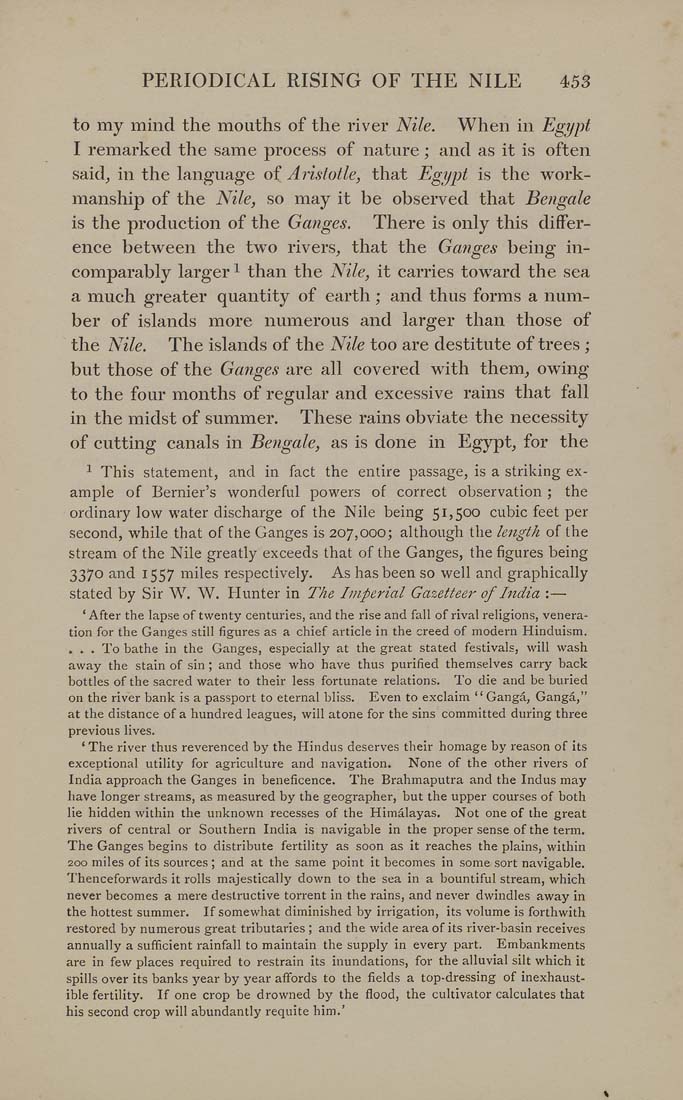PERIODICAL RISING OF THE NILE 4^53
to my mind the mouths of the river Nile. When in Egypt
I remarked the same process of nature; and as it is often
saidj in the language oi Aristotle, that Egypt is the work¬
manship of the Nile, so may it be obsei'ved that bengale
is the production of the Ganges. There is only this differ¬
ence between the two rivers^ that the Ganges being in¬
comparably larger ^ than the Nile, it carries toward the sea
a much greater quantity of earth; and thus forms a num¬
ber of islands more numerous and larger than those of
the Nile. The islands of the Nile too are destitute of trees ;
but those of the Ganges are all covered with them, owing
to the four months of regular and excessive rains that fall
in the midst of summer. These rains obviate the necessity
of cutting canals in Bengale, as is done in Egypt_, for the
^ This statement, and in fact the entire passage, is a striking ex¬
ample of Bernier's wonderful powers of correct observation ; the
ordinary low water discharge of the Nile being 51,500 cubic feet per
second, while that of the Ganges is 207,000; although the length of the
stream of the Nile greatly exceeds that of the Ganges, the figures being
3370 and 1557 miles respectively. As has been so well and graphically
stated by Sir W. W. Hunter in The Imperial Gazetteer of India :—
* After the lapse of twenty centuries, and the rise and fall of rival religions, venera¬
tion for the Ganges still figures as a chief article in the creed of modern Hinduism.
... To bathe in the Ganges, especially at the great stated festivals, will wash
away the stain of sin; and those who have thus purified themselves carry back
bottles of the sacred water to their less fortunate relations. To die and be buried
on the river bank is a passport to eternal bliss. Even to exclaim "Ganga, Ganga,"
at the distance of a hundred leagues, will atone for the sins committed during three
previous lives.
' The river thus reverenced by the Hindus deserves their homage by reason of its
exceptional utility for agriculture and navigation. None of the other rivers of
India approach the Ganges in beneficence. The Brahmaputra and the Indus may
have longer streams, as measured by the geographer, but the upper courses of both
lie hidden within the unknown recesses of the Himalayas. Not one of the great
rivers of central or Southern India is navigable in the proper sense of the term.
The Ganges begins to distribute fertility as soon as it reaches the plains, within
200 miles of its sources; and at the same point it becomes in some sort navigable.
Thenceforwards it rolls majestically down to the sea in a bountiful stream, which
never becomes a mere destructive torrent in the rains, and never dwindles away in
the hottest summer. If somewhat diminished by irrigation, its volume is forthwith
restored by numerous great tributaries ; and the wide area of its river-basin receives
annually a sufficient rainfall to maintain the supply in every part. Embankments
are in few places required to restrain its inundations, for the alluvial silt which it
spills over its banks year by year affords to the fields a top-dressing of inexhaust¬
ible fertility. If one crop be drowned by the flood, the cultivator calculates that
his second crop will abundantly requite him.'
|








